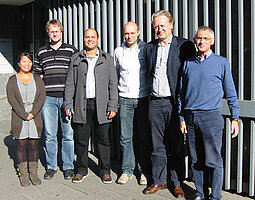Analysis of the cellular functions of the Dictyostelium strumpellin ortholog.
Applicants:
- PD Dr. med. Christoph S. Clemen
- Institut für Biochemie I, Medizinische Fakultät, Universität zu Köln
- Prof. Dr. rer. nat. Ludwig Eichinger
- Institut für Biochemie I, Medizinische Fakultät, Universität zu Köln
- Prof. Dr. med. Rolf Schröder
- Institut für Neuropathologie, Universitätsklinikum Erlangen
Mutations of the human strumpellin gene cause an autosomal-dominant form of Hereditary Spastic Paraplegia (SPG8; Valdmanis et al., 2007). In our previous work, we demonstrated that strumpellin is a ubiquitously expressed cytosolic and endoplasmic reticulum (ER) associated protein which directly interacts with the valosin containing protein (VCP, synonyms: p97, TER ATPase, Cdc48p) (Clemen et al., 2010). With respect to motoneuron diseases, the functional relationship between strumpellin and VCP is further highlighted by the observations that mutant VCP causes inclusion body myopathy with early-onset Paget disease and frontotemporal dementia (IBMPFD) (Watts et al., 2004) and amyotrophic lateral sclerosis with or without frontotemporal dementia (ALS14) (Johnson et al., 2010).
To elucidate the function of strumpellin and the pathophysiology of SPG8 we are generating a strumpellin knock-out mutant as well as strains that express tagged wild-type or N471D point-mutated variants of strumpellin in Dictyostelium discoideum. We will use our strains for localisation and co-localisation studies and to study the impact of strumpellin ablation or expression of point mutated strumpellin on mitochondrial function, membrane trafficking, proteasome function, and autophagy. These data shall provide novel insights into the cellular function of wild-type and mutant strumpellin in the context of Hereditary Spastic Paraplegia pathology.
October 2011
October 2012 Final Report
December 2012: further report here





